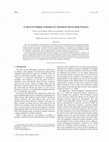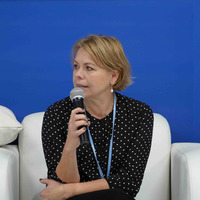Natural Science Papers by H. Langenberg

Monthly Weather Review 128: 3664-3673, 2000
The ‘‘spectral nudging’’ method imposes time-variable large-scale atmospheric states on a regiona... more The ‘‘spectral nudging’’ method imposes time-variable large-scale atmospheric states on a regional atmospheric model. It is based on the idea that regional-scale climate statistics are conditioned by the interplay between continental-scale atmospheric conditions and such regional features as marginal seas and mountain ranges. Following this ‘‘downscaling’’ idea, the regional model is forced to satisfy not only boundary conditions, possibly in a boundary sponge region, but also large-scale flow conditions inside the integration area. In the present paper the performance of spectral nudging in an extended climate simulation is examined. Its success in keeping the simulated state close to the driving state at larger scales, while generating smaller-scale features is demonstrated, and it is also shown that the standard boundary forcing technique in current use allows the regional model to develop internal states conflicting with the large-scale state. It is concluded that spectral nudging may be seen as a suboptimal and indirect data assimilation technique.
Papers by H. Langenberg

Deutsche Hydrographische Zeitschrift, 1999
ABSTRACT In this article, the hydrographic conditions are described which prevailed in the German... more ABSTRACT In this article, the hydrographic conditions are described which prevailed in the German Bight during the three KUSTOS experiments carried out in summer 1994, spring 1995, and winter 1996. It presents the physical background for the companion articles of this volume and provides insight into the complicated and highly variable hydrodynamics of the German Bight. Typically for the German Bight, the distribution of temperature and salinity in the near-bottom layer was found to relate strongly to the topography in all experiments, and variability in the vertical structure showed the expected seasonal pattern. The thermal and haline stratification were found to coincide in most cases, indicating a clear marking of surface and bottom water masses. Between the three KUSTOS experiments, the intensity of salinity fronts varied strongly, with stronger fronts in spring and weaker gradients in summer and winter, but from the limited number of observations this pattern cannot be generalised. The observed temperature and/or salinity patterns differ strongly from the average long-term situation, as expected in a highly variable area. To a large degree, this variability is caused by mesoscale features which - owing to their transient nature - are not well resolved by in-situ observations during the experiments and, therefore, numerical models are used to complement the observations. Finally, the overall mass transport through the German Bight during the KUSTOS experiments, estimated from a North Sea circulation model and a salt water budget and freshwater balance, ranges between 34 (strong cyclonic circulation) and -3 km3/d (weak anticyclonic circulation). North Sea water advection into the German Bight dominates river runoff by a factor of ∼15 (spring 1995) to ∼49 (winter 1996). However, in situations with a low through-flow in combination with a high ratio of freshwater inflow, residence times of river water can be high, thereby aggravating any harmful effects of riverine contaminants. In diesem Artikel werden die vorherrschenden hydrographischen Bedingungen wÄhrend der drei KUSTOS-Experimente beschrieben, die im Sommer 1994, Frühling 1995 und Winter 1996 in der Deutschen Bucht durchgeführt wurden. Er stellt den physikalischen Hintergrund für die anderen Artikel dieses Bandes dar und bietet einen Einblick in die komplizierte und überaus variable Hydrodynamik der Deutschen Bucht. In allen Experimenten ergab sich ein direkter Zusammenhang zwischen den bodennahen Verteilungen von Temperatur und Salzgehalt mit der Topographie. Die in den Experimenten beobachtete VariabilitÄt in den vertikalen Strukturen zeigte die zu erwartenden saisonalen Muster. Es wurde festgestellt, da\ sich die vertikalen Gradienten der Temperatur und des Salzgehaltes in den meisten FÄllen deckten, wodurch die Unterschiede der Wassermassen am Boden und an der OberflÄche deutlich werden. Die KUSTOS Experimente zeigen eine saisonal verÄnderliche IntensitÄt der Salzgehaltsfronten, mit im Frühjahr stÄrkeren und im Sommer und Winter schwÄcheren Gradienten. Allerdings lassen die verfügbaren Ergebnisse keine Verallgemeinerung dieses Ergebnisses zu. Keine der beobachteten Temperaturoder Salzgehaltsmuster zeigen einen engen Bezug zu der mittleren Lage über lange ZeitrÄume hinweg, wodurch sich die gro\e Bandbreite der VariabilitÄt zeigt. Da mesoskalige Merkmale, entsprechend ihrer kurzlebigen Natur, von den in-situ Beobachtungen wÄhrend der Experimente nicht gut aufgelöst wurden, wurden numerische Modelle benutzt, um die VariabilitÄt teilweise erklÄren zu können. Mit einem Zirkulationsmodell wird der Brutto-Massentransport durch die Deutsche Bucht der Nordsee berechnet; die Ergebnisse zeigen eine hohe VariabilitÄt des Massentransportes. Transporte in die Deutsche Bucht wÄhrend der KUSTOS Experimente reichen von 34 bis-3 km3/Tag, von starker zyklonaler zu schwacher anti-zyklonaler Zirkulation. Eine für die KUSTOS Experimente aufgestellte Salz-und Frischwasserbilanz bestÄtigt die Modellergebnisse und offenbart die Dominanz des in die Deutsche Bucht einströmenden Nordseewassers über die FlusswassereintrÄge. Vor allem im Fall geringen Massentransportes in Verbindung mit einem hohen Anteil an Frischwasserzuflu\ bedingt die entsprechend höhere Verweildauer eine VerstÄrkung der negativen Effekte der vom Flusswasser mitgeführten Schadstoffe.

Climate Research, 2000
ABSTRACT Two models of the North Sea are compared with respect to their performance in the assess... more ABSTRACT Two models of the North Sea are compared with respect to their performance in the assessment of sea level changes in a changing climate: the OPYC model, originally designed as a global ocean model and run in a regional version, and the HAMSOM, which was built as a shelf sea model and applied to an extended region in a simplified version. Both models agree very well in their hindcast skill as measured by correlation and explained variance. The reaction of both models to the '2 x CO2' and 'control' runs of the time slice experiments of the DKRZ (German Climate Computing Center) is also very similar and indicates an increase of up to 30 cm of winter mean sea levels and no significant (compared with the variability in the past) impact an the intra-monthly 90 % quantiles. It is concluded that sea level is a rather robust parameter that could still be assessed with some confidence if both models were simplified further.
Storm surges by H. Langenberg

Cont. Shelf Res. 19: 821-842 , 1999
The influence of a changing wind climate on the sea surface elevations along the North Sea coast ... more The influence of a changing wind climate on the sea surface elevations along the North Sea coast was investigated, with a statistical down-scaling technique and with a dynamical model. Firstly, in an analysis of past variability the two models were run for different periods: the numerical model for the winters 1955–1993 and the statistical one for the winters 1899–93. Secondly, a fine-scale time slice experiment for a control run and a scenario for doubled atmospheric carbon dioxide concentration was used (in both the dynamical and the statistical down-scaling model) to assess the sea level related changes due to an (anthropogenic) increase in atmospheric carbon dioxide concentration. Both models agree on the following results: (a) In the past, the winter means of high water levels along the North Sea coast increase on the order of 1–2 mm/yr, on account of only the atmospheric forcing; (b) the high intramonthly percentiles – reduced by the winter averages – show no clear trend; and (c) the British Coast exhibits a slight negative and the continental coast an equally small positive tendency. In the climate scenarios, the effect on the high percentiles follows the same pattern. A slightly larger and everywhere positive difference is diagnosed in the mean water levels along the North Sea coast. Together with the hindcast result, the above interpretations might suggest a continuing increase of mean water levels at the North Sea coast due to an increasing CO2 concentration in the atmosphere; this would occur throughout the second half of this century and, possibly, beyond. The high frequency variability appears to be much less affected. However, the natural variability of the system is too strong to clearly identify such a process, or attribute it to anthropogenic development. This study evaluates the impact of a changing atmospheric forcing only. Additional influences, such as the eustatic and isostatic effects, are not taken into account.









Uploads
Natural Science Papers by H. Langenberg
Papers by H. Langenberg
Storm surges by H. Langenberg